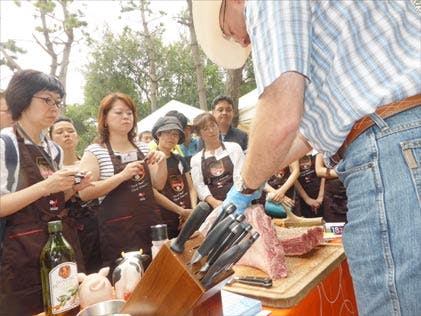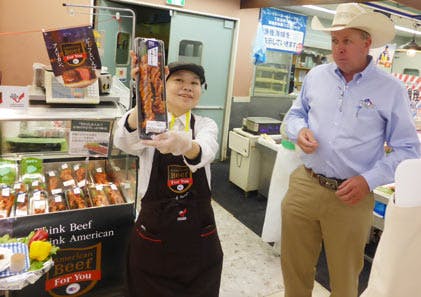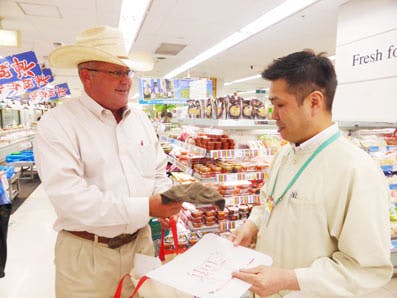Southwest Barbecue Team Delivers Flavor to Japanese Foodservice Industry, Consumers

Texas pitmaster Bryan Bracewell demonstrates to Japanese consumers the proper way to prepare meat for barbecue
In an effort to introduce the Japanese foodservice industry to authentic Texas barbecue and increase demand for U.S. beef, USMEF led a team of U.S. producers and a Texan pitmaster to Tokyo to present a barbecue seminar, meet Japanese food importers and participate in events designed to personally connect Japanese consumers to American farmers and ranchers. Funding support was provided by the Texas Beef Council.
The “Southwest Barbecue Team,” which later visited Korea on a similar mission, included Texas Beef Council members Bryan Forester and Ryan Moorhouse, Oklahoma producers Chuck and Ruth Coffey, Idaho Beef Council member Cevin Jones, Missouri corn producer Greg Schneider and renowned Texas pitmaster Bryan Bracewell.
While various styles of American barbecue have certainly gained popularity in Japan, the country has few authentic barbecue restaurants that use the “low and slow” method – or use the cuts of meat that make American barbecue unique, noted Greg Hanes, USMEF assistant vice president for international marketing, who accompanied the team to Japan. When Japanese think of barbecue, they think of thin-sliced yakiniku-style barbecue that is cooked at the table.

Idaho Beef Council member Cevin Jones ties an American scarf on a participant in an event during which producers met face-to-face with Japanese consumers
The barbecue seminar was held at the Tokyo Prince Hotel Garden Island restaurant, where approximately 100 hotel chefs, restaurant owners, buyers and distributors – along with U.S. packers and Japanese trade representatives – gathered to not only learn about barbecue, but also gain insight into the U.S. beef industry. David Miller, minister-counselor at the U.S. Embassy in Tokyo, joined Hanes in welcoming participants to the event and explaining the agricultural trade relationship between the U.S. and Japan. Takemichi Yamashoji, USMEF-Japan senior marketing director, provided an update on U.S. beef production and supplies, while the U.S. producers each took a turn talking about their farms and ranches.
“The people in Japan have a real fascination with American ranchers, and they have an interest in how food is produced in our country,” said Moorhouse, of Hartley, Texas. “Going there and meeting the people in person is a great idea. You could tell that they appreciated our presence and that they were taking in everything we were telling them about our cattle and our business.”

Texas Beef Council member Bryan Forester gets a look at how U.S. beef is packaged for sale in supermarkets
Bracewell, owner of Southside Market and BBQ near Austin, Texas, followed with an introduction to authentic Texas-style barbecue. He also offered a glimpse at the history and tradition of American barbecue, along with insights on proper cooking temperature and the use of rubs, smoking equipment and wood. During a subsequent barbecue preparation and cooking demonstration, it was pointed out that all grades of U.S. meat can be used to make American barbecue, but proper technique is critical for achieving tenderness. He then conducted a cooking demonstration using U.S. bone-in short ribs.
Participating Japanese chefs were impressed with the traditional cooking methods and the taste of the Texas barbecue.
“The ‘low-and-slow’ cooking method makes beef surprisingly tender,” said Akira Zenyoji, executive chef of Hotel Okura Tokyo. “This seminar was a very good opportunity to learn about new food trends and Texas barbecue. The demonstration did a good job of providing serving ideas and ways to better attract customers.”
On the day after the seminar, the team gathered at a park in Odaiba, an island in Tokyo Bay, to participate in a consumer event that featured American-style grilling of U.S. red meat. Hanes said more than 100 Japanese adults and children were present. Impressively, nearly 1,000 had applied to participate in the event.

Oklahoma beef producer Chuck Coffey discusses beef cuts with a Japanese retailer
“After introductions and a ceremony, members of our team mingled with the families and talked to them about their farms back home and about grilling American style,” said Hanes. “It was really a big deal, as was evident by the fact that so many wanted to be part of it. The media picked up on it and provided very positive publicity.”
During its stay in Japan, the team also visited the U.S. Embassy in Tokyo for a briefing on current import conditions. The group also met with beef and pork importers, visited meat distributors and retailers, viewed U.S. beef and pork promotions around the city and learned about competing suppliers and what other countries are doing to promote meat in Japan. At Nihon Butsuryu, a large cold storage operation in Tokyo, the team got a look at incoming shipments of U.S. beef and pork, as well as beef and pork purchased from competitors.
“It’s important for the team to see how the Japanese food import industry works, just as it is important for the Japanese to learn about the various sectors of the U.S. red meat industry,” Hanes said. “For example, it was a real asset having a representative from the corn industry on our team. We always stress how grain fed to our beef in the U.S. creates its flavor, so this was very beneficial when it came to highlighting the grain-fed aspect of U.S. beef.”
Greg Schneider, a Missouri Corn Merchandising Council board member from Warrenton, Missouri, was able to explain corn’s role with Japanese meat distributors and retailers.

Members of the Southwest Barbecue Team prepare to talk about their operations and the U.S. agriculture industry during the barbecue seminar at the Tokyo Prince Hotel
"The global livestock industry is a major user of U.S. corn," said Schneider. "One of the main reasons we were there was to showcase the superior quality of grain-fed U.S. beef over our competitors. Taste and quality are major factors for Japanese consumers, and that's where the corn-fed beef comes into play."
The Southwest Barbecue Team’s visit to Japan supplemented a summer-long effort by USMEF to promote American beef and pork barbecue. A nationwide retail campaign began in early July and included a special barbecue sauce developed by USMEF. A small packet of the sauce has been attached to consumer retail packages of U.S. beef and pork throughout the summer. More than 50 retailers with 4,500 outlets participated – and all 400,000 packages of the special barbecue sauce sold out early in the campaign.
